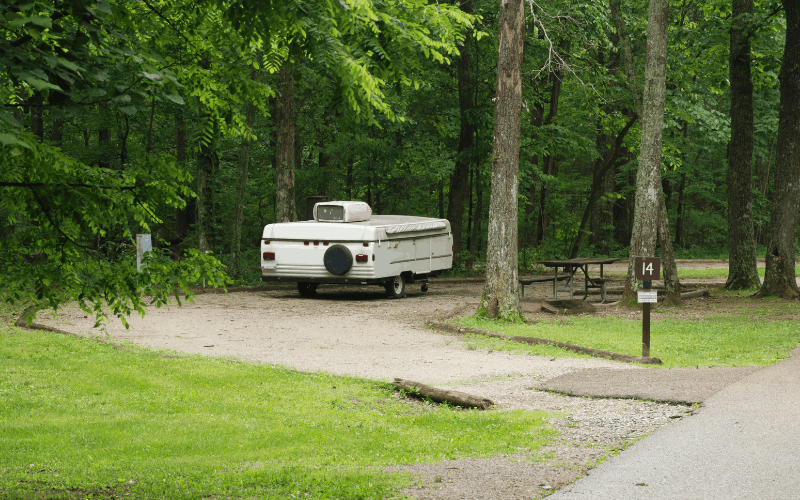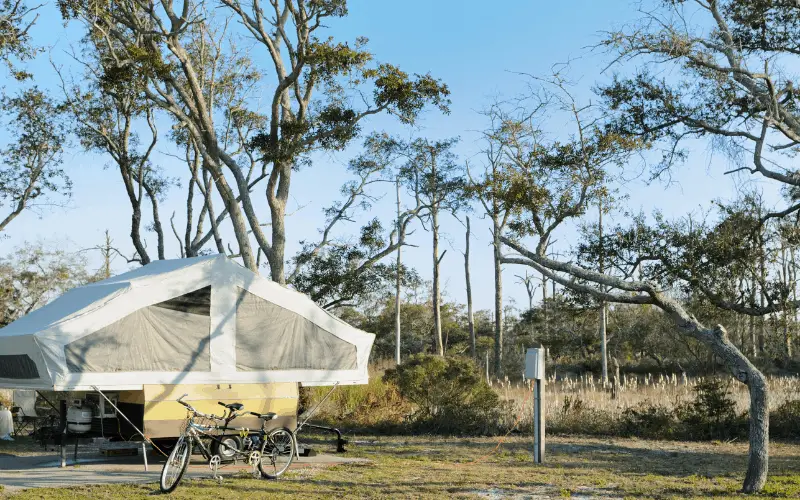Published Date: February 18, 2021
Last Updated on June 22, 2023 by Camper Front
Camping comes with a great deal of pleasure until the clouds start weeping bitterly and wreck all the fun.
And since the pop-up camper’s canvas is malleable and soft, stormy rains can likely pierce through.
A brand new model might not falter in the face of such furious weather conditions, but not so much for an old one – as they might have lost their water resilience over time.
So how do you waterproof a canvas on a popup camper to avoid leakage?
Today, I’m going to share with you an instant-working method on how to waterproof a canvas on a pop up camper – in four simple DIY steps.
Table of Contents
Why Should You Waterproof a Canvas On Pop-Up Camper?
Waterproofing is ongoing maintenance that is mandatory at your earliest convenience, because despite canvas campers being impermeable, with time they tend to lose their water-repellency.
But you have a choice: you can either keep patching the canvas and sleep with one eye open or join other happy campers that are waterproofing their trailers and experiencing comfort in the cat and dog weather.
The choice is yours!
But here are several reasons why adding a waterproof coat to your pop-up canvas is better:
Water damage is one of the biggest RV and trailer fun killers. A drop of water can cause the metals to corrode, and can even escalate to turning your comport into the PERFECT breeding ground for mold and mildew – making the entire motor home a health hazard.
For that reason, you can’t afford to have even the tiniest drop of water leakage.
The worst-case scenario is the camper becomes unsafe as the frame degrades. A simple hit from scrolling animals like a bear can force those soft sports to give way.
So without further ado, let’s delve into everything else you need to know about weatherproofing your pop-up camper canvas.
How Do You Waterproof A Canvas On A Popup Camper?

Step 1: Gather All the Necessary Tools
You will be needing the following pieces of equipment:
- Bucket
- Garden hose
- Soft bristle brush
- Mild soap
- Waterproofing Spray bottle product
- Ladder (we recommend either foldable or step ladders)
Step 2: Dust the surface
Before you apply the waterproofing product, be sure that the camper is free from dust and residue.
To do this, Set up the camper outside in an open area, away from trees and close to a water source.
Then extend the camper to its full height and length before washing it with a mild soap or detergents like Woolite and a soft brush.
Do not scrub it vigorously, as it may damage the fabric.
However, if the canvas is very messy like it has bird droppings, mold, or mildew, then you may need to apply a little pressure. Although that depends on the situation at hand –the type of fabric and how dirty the trailer is.
If the outer side of the camper is of vinyl materials, be sure the products you are using are vinyl friendly, else you may end up bringing harm to the surface, losing its waterproof as well.
Lastly, after washing the camper, rinse properly with a garden hose.
Step 3: Let it dry
The next step after it’s well rinsed is to let the popup camper dry fully.
Step 4: Apply a fresh lick of waterproofing coat
There are tons of waterproofing products flooding in and out of the market, so your options are almost limitless.
But be sure to pick the appropriate one for the camper’s material else you might not like the finish.
For instance, if you’re using a 303 fabric guard spray bottle, be certain it’s not on the vinyl side. I’ve seen a camper with a combination of both canvas and vinyl materials, and the 303 high-tech fabric guard doesn’t react well with it.
And that’s why we broke out a bottle that does the magic: the Camp Dry Water Repellent Spray.
It’s amongst the top-rated products on Amazon, and it’s as cheap as a chip. You can grab two spray bottles for less than $50.
Another cool thing about the Camp Dry Water Repellent Spray is its versatility.
They are ideal for tents, tarps, boots, hunting apparel, outdoor gear, boat covers, as well as patio furniture.
Furthermore, the treated material stays odor-free after drying. But ensure you apply and spread them evenly with a paintbrush to create an extremely tough water barrier.
Recommended Readings:
- How To Increase Space in a Pop Up Camper
- How Do You Carry A Kayak On An RV?
- Types of RV Windows
- How to Store a Pop Up Camper
- Different Types of RV Toilets
- Types of RV Roofs
Conclusion
So that’s that on how you waterproof a canvas on a popup camper.
In the long run, external elements might have their toll on the waterproofing, and like I said, ‘it’s ongoing maintenance.
Besides, it’s not nearly as difficult as you would have imagined (nor is it as expensive).
Some campers may recommend replenishing the canvas’s lost water repellency at least annually. But truth be told, there is no specific rule as to how frequently you should waterproof your canvas.
It depends solely on how often the surface is exposed to environmental elements, as well as how much wear-and-tear the surface material can take.
There is no harm in retreating too soon. only the new coat won’t stick to the fibers since it is water-repellent. Therefore, you will be wasting money.

